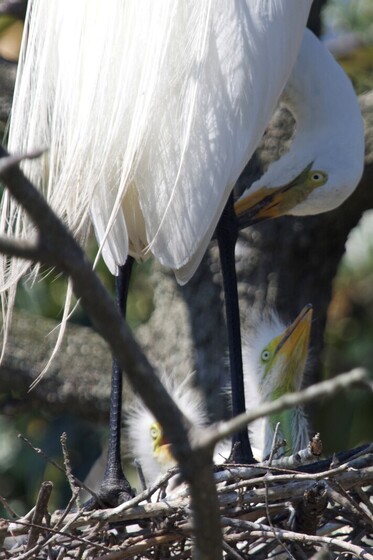 The Green Anole is the WildQuest 2023 mascot. Look for it at home or while playing WildQuest!
From April 28–May 7, 2023, join the Great Florida Birding and Wildlife Trail and the Florida Fish and Wildlife Conservation Commission for a scavenger hunt on select Wildlife Management Areas throughout the state. Use the free and easy-to-use GooseChase app to go on a wild adventure and discover some of Florida’s best spots to see wildlife and enjoy the outdoors. Play with friends and family or enjoy some solo fun outdoors.
Find a Wildlife Management Area near you with this map and join the quest here!
 A Great Egret nest with chicks in the rookery at St. Augustine Alligator Farm Zoological Park. Photo by Travis Blunden.
“In the late nineteenth century, George Reddington and Felix Fire began collecting alligators on Anastasia Island.”
So begins the story of St. Augustine Alligator Farm. What started as a roadside attraction has evolved over the years into a fully accredited zoo known for its conservation work as well as for being a staple of the local tourist industry. The facility hosts an impressive collection of reptiles and other creatures, but birders come for the rookery.
An impressive variety of wading birds nest above the zoo’s large outdoor alligator exhibit, including Roseate Spoonbills, Wood Storks and several species of herons and egrets. These birds are wild but have naturally chosen to take advantage of the favorable environment at the facility. Wading birds often form rookeries above alligator-inhabited waters. The large carnivorous reptiles discourage predators like racoons that would otherwise try to steal eggs and chicks for food. The location of the rookeries in tall trees over water usually also limits human access, but the rookery at St. Augustine Alligator Farm provides a rare opportunity to get up close in person with nesting birds and their young. The birds at this well-established rookery are unbothered by park visitors. They nest in trees right alongside an elevated boardwalk above the alligator pond, displaying their brilliant plumage while tending their nests and feeding their chicks barely a few feet from the railings. This year a Spoonbill nest in a cabbage palm over the boardwalk offers a delightful view of two fluffy pink chicks.
Spoonbills first nested in the rookery in 2010, although juveniles roosted there in previous years. By 2019, the number of Spoonbill nests had grown from four to seventy-one. Peak nest counts for all bird species in the rookery range between 400 and 800 each spring. Cattle, Great and Snowy Egrets generally have the highest nest count, but in 2021 Wood storks had a record one hundred and eleven nests. On arriving visitors may see many of these big birds flying over the park before encountering them in the rookery. Other regulars include Tricolored, Little Blue and Green Herons. See the typical rookery nesting schedule from February to August here. The rookery is also an excellent place to see Yellow-crowned and Black-crowned Night Herons from fall to early spring.
Learn more about the rookery at St. Augustine Alligator Farm here.
 Ribbon cutting wlecoming Chinsegut to the GFBWT. Left to right: Allie McCue, Southwest Regional Director of the FWC, Tammy Heon, Manager of Tourism Development for Florida’s Adventure Coast, Hana Brinkley, head of Chinsegut Conservation Center and Lauren Ali, coordinator of the Great Florida Birding and Wildlife Trail. Photo by Andrew Wraithmell.
On Saturday April 15, the great Florida Birding and Wildlife Trail welcomed Chinsegut Wildlife and Environmental Area as its nineth Gateway site. Gateways are specially selected sites that put the “Great” in Great Florida Birding and Wildlife Trail. They are known for two things: having some of the best birding and wildlife viewing in Florida, and offering excellent educational opportunities. At Gateway sites, visitors not only experience and learn about Florida’s wildlife and ecosystems, they can also access GFBWT resources like bird and butterfly checklists, Trail guides and more.
The area that is now Chinsegut WEA has historically been an important part of the Brooksville community, and has become even more so since the opening of its conservation center in 1986. Chinsegut offers numerous opportunities for residents and visitors to get involved with outdoor activities, experience local wildlife and to unwind, rest and recharge in a natural setting. Affectionately known as the Redheaded Woodpecker capital of the world, Chinsegut is also a great place to encounter Sandhill Cranes, nesting Chimney Swifts and many of the other 155 bird species recorded there, along with deer, gopher tortoises, bobcats and more. The conservation center works closely with the Hernando Audubon Society, a longtime champion of environmental education at the site. Beginning Birding walks are conducted weekly to intoduce the local commnity to the wonders of birds.
Chinsegut offers many such programs to introduce residents and visitors to important local wildlife and habitats, enriching people’s sense of place, knowledge of local natural communities and what is required to keep them healthy. Guided hikes introduce the concept of “Right plant, right place” in home landscapes, empowering participants to create healthy backyard environments for native wildlife by understanding the seasonal cycles of the native plants local wildlife need to thrive. Chinsegut also partners with UF/IFAS Extension to provide resources and educational events that introduce the public to a wide range of topics including entomology, Florida friendly landscaping, composting, and rain barrels. Hernando County has assisted with educational programs about macroinvertebrates and more at the new outdoor classroom at May’s Prairie. A new partner, the UF Center for Autism and Related Disabilities, helps provide staff with resources and training for how best to serve members of that community.
The Great Florida Birding and Wildlife Trail is excited to welcome Chinsegut as our newest Gateway. Learn more about Chinsegut WEA on our website.
|